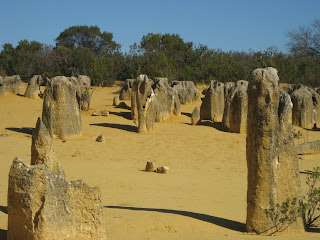
We arrived at the National Park and had a look in the Visitors Centre where I learned the origin of the Pinnacles is still a mystery. There are several theories, but most involve formation of calcareous sheaths around large roots. Eventually, the roots rotted away and the columnar shapes filled with sand. The columns may have been unburied and reburied by sand dunes over time, and fossil soil layers and other fossils including aboriginal artifacts have been found cemented in the pinnacles themselves. The estimated age of the pinnacles is about 500,000 years before present. More information here.



After walking around the Pinnacles and sort-of getting lost, we headed back south to Perth. We made a stop at the Yanchep National Park, where we took a cave tour and saw some kangaroos and koalas.
 The cave was interesting because it was relatively shallow. There were tree roots inside that ran along the stairs and come down from the ceiling in search of water. There was also a small pool inside that housed a rare species of cave-dwelling crustaceans (family: Crangonyctidae). Water has to be pumped into the cave to support a root mat which provides a food source for the Crystal Cave Crangonyctoid. There are also other caves in the region with similar situations and species that are endemic to one cave. The last few winters have been dry in Western Australia, so water levels have been really low. Our tour guide seemed very concerned.
The cave was interesting because it was relatively shallow. There were tree roots inside that ran along the stairs and come down from the ceiling in search of water. There was also a small pool inside that housed a rare species of cave-dwelling crustaceans (family: Crangonyctidae). Water has to be pumped into the cave to support a root mat which provides a food source for the Crystal Cave Crangonyctoid. There are also other caves in the region with similar situations and species that are endemic to one cave. The last few winters have been dry in Western Australia, so water levels have been really low. Our tour guide seemed very concerned.On a happier note, I learned the Latin name for koala (Phascolarctos cinereus) means 'ash-coloured pouched-bear.'


No comments:
Post a Comment